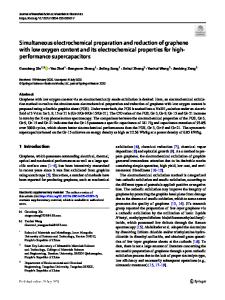Anatase Inverse Opal: Preparation and Electrochemical Properties
- PDF / 1,259,032 Bytes
- 6 Pages / 612 x 792 pts (letter) Page_size
- 25 Downloads / 357 Views
R5.3.1
Anatase Inverse Opal: Preparation and Electrochemical Properties Marketa Zukalova, Martin Kalbac and Ladislav Kavan J. Heyrovsky Institute of Physical Chemistry, Academy of Sciences of the Czech Republic, Dolejskova 3, CZ-182 23, Prague 8, Czech Republic ABSTRACT Anatase inverse opal was synthesized both in the powder form and in the thin layer by means of templating with latex spheres. The voids between close-packed latex particles were filled via deposition from the titanium (IV) isopropoxide solution, electrochemical deposition from the solution of TiCl3, and liquid phase deposition from the (NH4)2TiF6 solution. The resulting material exhibited a regular fcc ordering of macropores surrounded with the framework consisting of the anatase nanocrystallites of 20 nm in size. Electrochemical performance for lithium insertion of anatase inverse opal was sluggish compared to that of non-templated anatase with more dense packing of nanocrystals.
INTRODUCTION Anatase inverse opal is a macroporous solid with highly ordered porous structure over a large area, which has attracted considerable interest recently [1-5]. High refractive index of the wall material together with a pore size of hundreds nanometers (comparable to the wavelengths of visible light) are responsible for its photonic crystal properties. Owing to its ability to inhibit the range of wavelengths from propagation through the material over all directions, this unique structure offers many applications in sensors, optoelectronics, chromatography, and photocatalysis. Recently, Mallouk et al.[6] reported on the enhancement of the light harvesting efficiency of the dye-sensitized solar cell (Grätzel cell) by coupling a TiO2 photonic crystal layer to a conventional film of TiO2 nanoparticles. By tailoring of the stop band position, this assembly could improve the photocurrent efficiency by 26% due to localizing of the red part of solar spectrum in the composite structure [6]. The efficiency of the photoanode of the dye-sensitized solar cell could be strongly influenced either by structural parameters or by electrochemical properties of the composite materials of this electrode. Hence, deeper insight into the structure of anatase inverse opal together with the study of its electrochemical properties provide necessary feedback for tuning the synthetic protocol of anatase inverse opal with respect to the best performance of this structure in the dye-sensitized solar cell. Structure and texture of anatase inverse opal were studied by SEM, TEM, XRD, Raman spectroscopy, and nitrogen adsorption measurements. Properties of our material were also investigated by lithium insertion electrochemistry. Because of the similarity in heterogeneous charge-transfer processes taking place either during lithium insertion into anatase lattice or during transport of electrons from the photoexited dye to the back contact of the photoanode of Grätzel cell, this method represents a possibility to evaluate the applicability of anatase inverse opal in the dye-sensitized solar cell.
Data Loading...










